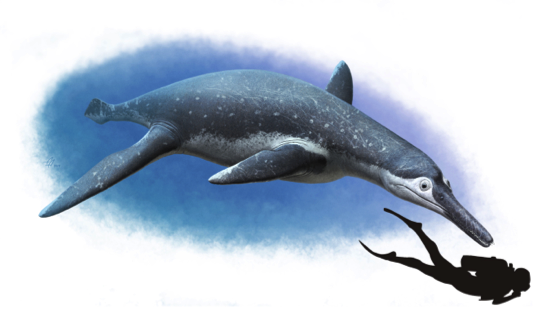Fossil Of Bus-Sized Marine Reptile Species From The Age Of Dinosaurs Discovered In Russia

A body of the size of a bus, a large skull over five feet in size, enormous sharp, conical teeth and an equally powerful jaw, topped by a beak- or snout-like feature, and four large flippers. No, it’s not a monster from a work of fiction, it is a new species of pliosaur whose fossil was found in Russia.
Pliosaurs were large predatory marine reptiles that lived at the same time as dinosaurs, though they perhaps showed up somewhat later, with the oldest fossils being dated to about 135 million years ago. They had a body shape that was unique among marine vertebrates at the time (though it looks something along the lines of a duck-billed platypus), including stiff trunks and a large variation in neck lengths among different species.
The new species from Russia has been named Luskhan itilensis and was described in a paper published Thursday. The fossil of L. itilensis was found in August 2002 on the right bank of the Volga River in Russia, close to the city of Ulyanovsk. Accordingly, the name given to it means “master spirit from the Volga.”
Read: Three Extinct Marsupial Species Discovered In South America
The fossil of L. itilensis was extremely well-preserved and it showed a very unusual pliosaur. Its rostrum was extremely slender, similar to those found in fish-eating aquatic animals like the gharial or some species of dolphins, like the bottlenose dolphin.
“This is the most striking feature, as it suggests that pliosaurs colonized a much wider range of ecological niches than previously assumed,” Valentin Fischer of the Université de Liège, Belgium and lead author of the paper, said in a statement Thursday.
Pliosaurs were a suborder under the order of plesiosaurs, and the researchers behind the new paper compared the anatomy and ecomorphology of plesiosaurs, using comprehensive data sets. They found that several evolutionary convergences took place in their evolution, particularly after an extinction event at the end of the Jurassic Period about 145 million years ago. Evolutionary convergence refers to the phenomenon of evolution of distantly related species to resemble each other, because of their similar roles in their respective ecosystems.
The findings published in the paper also inform that pliosaurs survived the extinction event at the end of the Jurassic, and bounced back, before finally becoming extinct. Their disappearance came many millions of years before the mass extinction event 65 million years ago that killed all the dinosaurs (except birds).
The fossil was discovered by Gleb N. Uspensky from Ulyanovsk State University, who was one of the co-authors of the paper. Titled “Plasticity and convergence in the evolution of short-necked plesiosaurs,” it appeared online in the journal Current Biology.
Pliosaurs, while existing at the same time as dinosaurs, were not related to the land giants. Instead, they were distant cousins of modern turtles. They were also the top marine predators of their time.
© Copyright IBTimes 2024. All rights reserved.




















